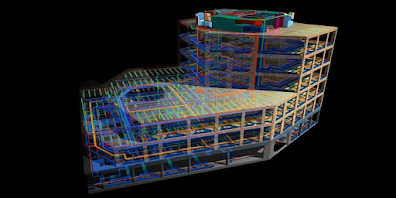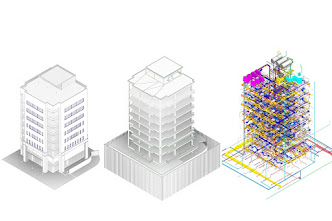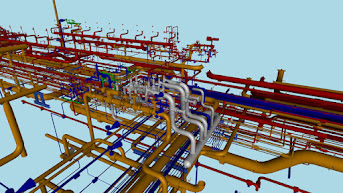What is 4D BIM Modeling Services?
In the dynamic world of construction and engineering, staying ahead of the curve is essential to delivering successful projects. One such groundbreaking technology that has revolutionized the industry is 4D BIM Modeling Services. But what exactly is 4D BIM, and how can it benefit your projects? In this comprehensive guide to Silicon Valley, we'll explore the ins and outs of 4D BIM, unraveling its concepts in simple words for easy understanding.
4D BIM Modeling Services is a process that integrates a 3D digital model of a building or infrastructure project with time or schedule-related information. This allows project teams to visualize and simulate the construction process, from start to finish.
The term "4D" refers to the fourth dimension, which is time. In 4D BIM, the 3D model is linked to a timeline, which shows the sequence of construction activities. This allows project teams to see how the project will progress over time, and to identify potential problems or bottlenecks.
In other words, 4D BIM Modeling Services is a way to visualize the construction process in a way that is more realistic and accurate than traditional 2D drawings. This can help to improve the efficiency, cost-effectiveness, and communication of your construction project.
Understanding 4D BIM Modeling Services:
4D BIM: A Technological Aspect
At its core, 4D BIM stands for 4D Building Information Modeling, a sophisticated approach that takes conventional 3D modeling to the next level. By incorporating the dimension of time into the equation, 4D BIM becomes a dynamic and interactive tool for visualizing and managing the entire construction project lifecycle.
How Does it Work?
Picture this: 4D BIM Services add a temporal dimension to 3D models, virtually mapping out the construction timeline. Each task is meticulously linked to a specific point in time, enabling the model to automatically update as the project progresses. This unparalleled integration of time and space allows construction professionals to foresee potential conflicts, streamline processes, and make informed decisions with precision.
Benefits of 4D BIM:
- Enhanced Visualization: With the time aspect integrated into 3D models, stakeholders can effortlessly grasp the sequence of construction activities. This visual representation fosters better comprehension and communication among all parties involved.
- Improved Collaboration: Gone are the days of isolated teams! 4D BIM Services empower architects, engineers, contractors, and clients to access and interact with a single, updated model. This seamless collaboration leads to efficient problem-solving and smoother project execution.
- Efficient Planning and Scheduling: Project managers, armed with 4D BIM, can create meticulous construction schedules, considering not just the order of tasks, but also their durations. This level of detail ensures optimal resource allocation, minimizing delays and cost overruns.
- 4D Construction Simulation: Brace yourself for the future! 4D BIM enables construction teams to virtually simulate the construction process, identifying potential bottlenecks and clashes beforehand. This virtual trial-and-error approach saves invaluable time and resources on-site.
- 4D Planning and Scheduling: The heart of project management lies in meticulous planning and scheduling. With 4D BIM Services, construction professionals can develop comprehensive plans, taking into account various stages of construction, from groundbreaking to final delivery.
4D BIM Modeling Services represent the epitome of innovation in the construction industry. By merging the element of time with 3D models, this technology empowers teams to visualize, coordinate, and execute projects with unparalleled efficiency. From improved collaboration to enhanced planning and simulation, the benefits of 4D BIM are boundless. Embracing this advanced tool can lead to faster, smoother, and more successful project deliveries, revolutionizing the future of construction as we know it.
4D BIM Modeling Services can be used for a variety of purposes, including:
- Planning and scheduling: 4D BIM models can be used to create detailed construction schedules, taking into account the dependencies between different activities. This can help to identify potential conflicts and bottlenecks and to ensure that the project is completed on time and within budget.
- Risk management: 4D BIM models can be used to identify potential risks in the construction process, such as clashes between different elements or delays in the delivery of materials. This can help to mitigate these risks and to ensure that the project is completed smoothly.
- Communication: 4D BIM models can be used to communicate the construction process to different stakeholders, such as clients, contractors, and regulatory authorities. This can help to ensure that everyone is on the same page and that the project is completed to everyone's satisfaction.
If you are considering using 4D BIM services for your next construction project, there are a few things you should keep in mind:
- The quality of the 3D model is critical: The 3D model that is used to create the 4D BIM model must be accurate and complete. If the model is not accurate, the 4D BIM model will not be accurate either.
- The 4D BIM model must be updated regularly: As the construction project progresses, the 4D BIM model must be updated to reflect the latest changes. This will ensure that the model is always up-to-date and that it can be used to accurately track the progress of the project.
- 4D BIM software can be expensive: 4D BIM software can be expensive, but there are some free and open-source options available.
Future Applications of 4D BIM:
The potential of 4D BIM Modeling Services extends far beyond its current applications. As technology advances, we can expect even more exciting possibilities for this game-changing tool. Here are some future applications to keep an eye on:
- Facility Management: Imagine having a dynamic 4D model of a completed building that serves as a blueprint for its maintenance and operation. 4D BIM could revolutionize facility management, enabling efficient maintenance scheduling, real-time updates on assets, and data-driven decisions for optimal building performance.
- Clash Detection and Risk Mitigation: As 4D BIM evolves, it holds the promise of becoming an even more powerful clash detection and risk mitigation tool. Artificial intelligence and machine learning algorithms could be integrated to identify potential clashes and risks automatically, further enhancing project efficiency and safety.
- Augmented Reality Integration: The integration of 4D BIM with augmented reality (AR) is an exciting prospect on the horizon. AR could overlay the 4D model onto the construction site, allowing teams to visualize and compare the virtual and physical worlds in real time, leading to unprecedented accuracy and precision.
- Sustainability and Energy Analysis: With the increasing emphasis on sustainable construction practices, 4D BIM could play a vital role in energy analysis and environmental impact assessment. It could help optimize building designs for energy efficiency, water usage, and overall sustainability.
Challenges and the Path Forward:
While 4D BIM Modeling Services hold immense promise, there are challenges that the industry needs to address. One major hurdle is the adoption of this technology across the construction sector. Training and educating professionals about 4D BIM's capabilities and benefits will be crucial in driving widespread implementation.
Additionally, data management and interoperability between different BIM software platforms remain a concern. Standardization efforts and collaboration among software developers are essential to ensure seamless data exchange.
4D BIM Modeling Services are reshaping the construction industry, offering unprecedented opportunities for visualization, collaboration, and efficiency. Embracing this technology will be key to staying competitive in a rapidly evolving landscape. As the industry moves towards greater sustainability and innovation, 4D BIM will undoubtedly play a pivotal role in shaping the buildings and infrastructure of tomorrow. The future is bright, and 4D BIM is leading the way!
Collaboration and Knowledge Sharing:
As 4D BIM Modeling Services gain traction, collaboration among construction professionals becomes more critical than ever. Embracing this technology necessitates breaking down silos and fostering a culture of knowledge sharing. Architects, engineers, contractors, and project managers must come together to leverage the full potential of 4D BIM.
By working collaboratively, teams can identify innovative solutions, share best practices, and learn from each other's experiences. This collective intelligence will lead to continuous improvement and the advancement of construction practices as a whole.
Educational Initiatives:
To fully harness the power of 4D BIM, educational institutions play a vital role. Integrating 4D BIM into construction-related curricula can prepare the next generation of professionals with the skills and expertise needed to drive the industry forward. Hands-on training and real-world project simulations using 4D BIM tools can empower students to excel in the construction domain.
Furthermore, continuous education and professional development programs for industry veterans are essential to ensure they remain up-to-date with the latest advancements in 4D BIM technology and its applications.
Empowering Small and Medium-Sized Enterprises (SMEs):
While larger firms have been quick to adopt 4D BIM Modeling Services, smaller enterprises may face barriers due to limited resources and access to technology. To promote inclusivity and foster industry-wide growth, initiatives should be put in place to support SMEs in their adoption journey.
Government Support and Standards:
Government bodies can play a pivotal role in driving 4D BIM adoption by mandating its use in public infrastructure projects. By setting standards and guidelines for BIM implementation, governments can encourage the construction industry to leverage 4D BIM for greater efficiency, transparency, and cost-effectiveness.
4D BIM Modeling Services have emerged as a transformative force in the construction industry. By adding the time dimension to 3D models, this technology unlocks new levels of visualization, collaboration, and efficiency. As the industry moves towards a more sustainable and innovative future, embracing 4D BIM will be crucial to achieving these goals.
From enhanced project planning and scheduling to immersive construction simulations, 4D BIM offers immense potential for streamlining construction processes and delivering successful projects. With collaborative efforts, educational initiatives, and government support, the construction industry can fully harness the power of 4D BIM, paving the way for a brighter and more efficient future. Let's embrace this cutting-edge technology and build a better world together!
Social Impact and Sustainability:
Beyond its direct impact on construction projects, 4D BIM Modeling Services also hold significant potential for promoting social impact and sustainability. As construction plays a crucial role in shaping our built environment, the responsible use of 4D BIM can contribute to a more sustainable and inclusive future.
- Sustainable Design: 4D BIM allows construction professionals to optimize building designs for energy efficiency, water conservation, and waste reduction. By simulating different design scenarios, teams can identify the most sustainable options, minimizing the project's environmental footprint.
- Inclusive Planning: When used in infrastructure projects, 4D BIM can facilitate inclusive planning, considering the needs of all stakeholders, including those with disabilities. By visualizing the construction process, potential barriers to accessibility can be identified and addressed from the outset.
- Disaster Preparedness: 4D BIM Services can also contribute to disaster preparedness and response. By simulating emergency scenarios, construction teams can develop strategies to minimize damage and ensure the safety of occupants during unforeseen events.
- Cultural Heritage Preservation: In historic restoration projects, 4D BIM can aid in preserving cultural heritage. By creating detailed models of historical structures, conservation efforts can be better planned, ensuring the preservation of invaluable heritage for future generations.
Embracing a Sustainable Future:
As the construction industry embraces 4D BIM Modeling Services, it must also adopt sustainable practices to create a positive impact on the environment and society. This can be achieved by incorporating green building materials, implementing renewable energy solutions, and promoting eco-friendly construction techniques.
Additionally, supporting local communities, fostering diversity, and ensuring ethical labor practices are essential in promoting social impact and inclusivity within the construction sector.
4D BIM Modeling Services represent more than just a technological advancement in construction. They hold the potential to transform the industry, making it more efficient, collaborative, and sustainable.
By integrating the dimension of time into 3D models, 4D BIM empowers construction professionals to visualize, plan, and execute projects with unparalleled precision. From improving collaboration to enhancing disaster preparedness and sustainability, the benefits of 4D BIM are far-reaching.
As we embrace this transformative tool, let us also commit to responsible and sustainable practices that create a positive impact on the environment and society. Together, we can build a future that is not only structurally sound but also socially and environmentally responsible.
Also, check our blog - Exploring the Advantages of 4D BIM Modeling Services in Construction Projectshttps://siliconvalleycad.weebly.com/blog/july-03rd-2023



Comments
Post a Comment